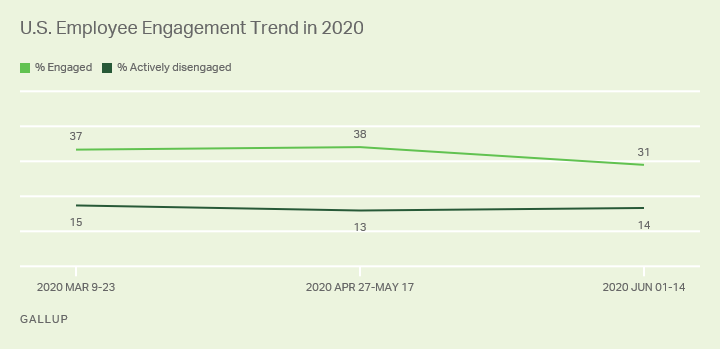Story Highlights
- This is the most significant drop in U.S. employee engagement since 2000
- Leaders and managers are affected the most
- Workplace engagement is highly related to building an inclusive culture
Gallup is closely tracking the engagement and wellbeing of the workforce during this unprecedented time of disruption. We are providing the latest updates for organizational leaders so they can understand the impact on the workplace and what their people need most during this time of rapid change.
In early May, employee engagement in the U.S. accelerated to a new high.
Now, one month later, Gallup tracking finds the most significant drop we have recorded in our history of tracking employee engagement in the U.S., dating back to 2000.

Line graph showing the U.S. employee engagement trend in 2020 so far. Surveys from March 9-23, 2020, show that 37% were engaged and 15% were actively disengaged. Surveys from April 27-May 17, 2020, show that 38% were engaged and 13% were actively disengaged. And the most recent survey from June 1-14 shows that 31% were engaged and 14% were actively disengaged.
Gallup found early last month, the percentage of "engaged" workers in the U.S. -- those who are highly involved in, enthusiastic about, and committed to their work and workplace -- reached 38%. This is the highest it has been since Gallup began tracking the metric in 2000. Now, with the measurement from June 1-14 following the killing of George Floyd in late May and subsequent protests and riots on top of a pandemic, unemployment, and attempts to re-open some businesses, 31% of the working population are engaged. Taking into consideration three Gallup measures of employee engagement this year, the overall percentage of engaged workers during 2020 is 36%.
Since employee engagement is highly related to many performance outcomes -- even more so in tough times -- this unprecedented drop in the percentage of engaged workers has significant potential performance consequences.
The percentage of workers who are "actively disengaged" -- those who have miserable work experiences and spread their unhappiness to their colleagues -- remained at approximately the same engagement level. It was 14% in June compared to 13% in early May. This drops the ratio of engaged to actively disengaged employees from 3.0-to-1 to 2.2-to-1 in the U.S., the lowest ratio since 2016. These findings are based on a random sample of 2,687 full- and part-time U.S. employees working for an employer from June 1-14, 2020.

Line graph showing the U.S. employee engagement trend in annual averages from 2000 through 2020. The percent engaged in 2000 was 26% and then it increased relatively steadily until 2019, when it was 36% engaged. The 2020 figure is based on three survey dates in 2020 so far, and the average percent engaged is 36%. The percent of U.S. employees who were actively disengaged in 2000 was 18%. This figure hit a high point in 2007 at 20% actively disengaged, but then continued a relatively steady decline until the 13% actively disengaged rating from 2019. The 2020 average so far is 14% actively disengaged.
The remaining 54% of workers are "not engaged" -- they are psychologically unattached to their work and company. These employees put time, but not energy or passion, into their work. Not engaged employees typically show up to work and contribute the minimum effort required. They're also on the lookout for better employment opportunities and will quickly leave their company for a slightly better offer.
Engagement Among Managers and Leaders Drops
The largest decline in employee engagement was among those in managerial or leadership positions, as well as non-White respondents and those with Democratic political party affiliation or independents. The drop was also sharper for people working on-site versus at home as well as among blue-collar or service workers. The drop was larger for men than women.
Since mid-March, Gallup has been tracking the way employers respond to the coronavirus. Between March and early April, employees expressed that their employers had improved in their communication and preparedness. This perception of their employers had since leveled off up until June when employees said they felt much less prepared to do their work and rated employer and supervisor communication lower. Self-reported social distancing among employees is also lower.
The recent drop in employee engagement is highly uncharacteristic, given the steadiness of past trends with only gradual improvements over time. Even the past recessions of 2001-2002 or 2008-2009, the attack on 9/11 and subsequent aftermath, and prior pandemics have not significantly dented employee engagement in the U.S. Given some of the demographic trends noted above, some possible reasons for the precipitous drop in the percentage of engaged workers are:
- The societal unrest following the killing of George Floyd has created disruptions within the workplace, making it more difficult for leaders to attend to performance-related engagement elements -- diversity and inclusion challenges are heightened like never before.
- Employers have taken their focus off -- or have been unclear in -- their plans, as businesses within many states began to reopen in June.
- Some previously laid-off employees are returning to the workforce. In May, Gallup found those who were employed and then laid off or furloughed had slightly lower engagement than those who continued to be employed. But this would only explain a very slight drop in engagement and isn't the likely cause of a seven-percentage-point drop.
Since employee engagement is highly related to many performance outcomes -- even more so in tough times -- this unprecedented drop in the percentage of engaged workers has significant potential performance consequences.
Unclear Communication Strains Engagement
Improving employee engagement starts with clarity among leaders and managers. If leaders and managers are unclear in communicating about matters such as plans moving forward or how the organization is responding to racial injustice, then it is highly unlikely that their direct employees will have clarity on these things. And clarity is crucial, as more engaged leaders have more engaged managers who then have more engaged employees.
Improving employee engagement starts with clarity among leaders and managers.
In reality, there are many potential compounding factors that likely contribute to the sharp decline in employee engagement -- lack of clear direction and uncertainty about returning back to the workplace following state openings, continued health and financial risk, and the societal unrest around race relations.
It is likely that last topic producing a significant burden for managers and leaders as they attempt to understand and repair racial tensions and build inclusive cultures in their organizations. It's also likely that managers and leaders have needed time to reevaluate their policies and practices regarding fairness, inclusiveness and promotion practices.
Related to this trend in declining employee engagement, Gallup tracking found that daily anger and sadness spiked during the first week of June, following the killing of George Floyd in Minneapolis.
Even in the midst of much uncertainty and heightened tensions, it is more important than ever that leaders and managers focus on the elements that engage workers -- workplace engagement is highly related to building an inclusive culture. It is also crucial to audit attraction, hiring and promotion practices to increase diversity among senior management, which has been sorely lacking in most organizations within the U.S.
The question that only time will answer is: Is this historic drop in workplace employee engagement temporary or long-lasting?
Get the support you need to create an engaged workplace that will carry you into the "next normal" workplace:
- Use what Gallup knows about how people and workplaces behave in crisis to effectively lead through COVID-19 disruption.
- Partner with Gallup to find an engagement solution that works for your unique business circumstances.
- Download COVID-19: A Leader's Guide to Developing a Work-From-Home Strategy or attend the webinar for the latest data and insights on remote work.




